Complete Guide to RPA Business Solutions for Enterprises
Robotic Process Automation (RPA) has emerged as a foundational technology for enterprises seeking to streamline operations. RPA Business Solutions enable organizations to automate repetitive tasks, allowing human teams to focus on higher-value activities.
Whether you are evaluating Robotic Process Automation Solutions or planning RPA Business Automation, understanding its mechanics, applications, and strategic integration is essential for informed decision-making.
By 2030, the global RPA market is projected to surpass $13 billion, representing a sharp rise from its current value of just over $1 billion in 2020. (Statista, 2025)
Understanding RPA Fundamentals
At its core, RPA mimics human interactions with digital systems. It deploys software bots to handle rule-based processes, such as data entry or invoice processing, without altering underlying infrastructure. Since RPA does not require changes to existing infrastructure, it is easier and faster to integrate into business operations.
The advantages of RPA extend beyond task automation and simple installation to broader organizational agility, such as task efficiency, accuracy in operations, compliance assurance, cost management, and process visibility.
Key Components of RPA Business Solutions
Effective RPA for Enterprises relies on interconnected components. Identifying them helps in selecting the right Robotic Process Automation Solutions.
Software Platforms
Central to any RPA Enterprise Solutions stack is the platform itself. Leading options include:
- Orchestration tools for bot management.
- Development interfaces for custom bot creation.
- Monitoring modules for performance tracking.
Bot Development and Deployment
Bots are built using drag-and-drop designers or scripting languages. Deployment involves:
- Testing in sandbox environments.
- Scheduling for peak or off-peak runs.
- Integration with APIs for data flow.
Supporting Infrastructure
RPA thrives with robust backend support:
- Secure servers for hosting the bots.
- Data repositories for input/output storage.
- Analytics engines for optimization.
| Component | Role in RPA Business Automation | Example Use Case |
| Orchestration Tool | Coordinates multiple bots | Managing invoice cycles across departments |
| Bot Designer | Builds workflow logic | Automating report generation from spreadsheets |
| Monitoring Dashboard | Tracks bot health and errors | Identifying bottlenecks in payroll processing |
This table illustrates how components interlink to deliver comprehensive RPA Enterprise Solutions.
Implementing RPA in Enterprises
Rolling out RPA Business Solutions requires a structured approach. Enterprises should align implementation with business objectives to maximize value.
Step-by-Step Deployment Process
Process Identification: Map operations to pinpoint automation candidates, prioritizing those with high repetition and low variability.
Feasibility Assessment: Evaluate the tools and skills required, ensuring compatibility with existing systems.
Pilot Program: Launch small-scale bots in one department to refine workflows.
Full-Scale Rollout: Expand to multiple areas, incorporating feedback loops.
Ongoing Optimization: Regularly update bots based on process evolutions.
Best Practices for Success
- Involve cross-functional teams early to foster buy-in.
- Start with simple processes to build momentum.
- Establish governance for bot security and updates.
By following these steps, RPA for Enterprises transitions from concept to operational reality.

Addressing Challenges in RPA Business Automation
No technology rollout is without hurdles. RPA Enterprise Solutions present specific obstacles, but targeted strategies mitigate them.
Common Hurdles
- Integration Complexities: Legacy systems may resist seamless bot connections.
- Skill Gaps: Teams might lack expertise in bot design.
- Change Resistance: Employees could view automation as a threat.
Mitigation Strategies
Use the following table to navigate these issues:
| Challenge | Potential Impact | Resolution Approach |
| Integration Complexities | Delayed deployment | Leverage API wrappers or middleware adapters |
| Skill Gaps | Inefficient bot builds | Invest in vendor training or hire specialists |
| Change Resistance | Low adoption rates | Conduct workshops emphasizing role enhancement |
Proactive handling ensures RPA Business Solutions delivers intended outcomes.
Case Studies: RPA in Action
Real-world applications highlight RPA’s versatility. In finance, bots automate reconciliation, matching transactions across ledgers. Healthcare enterprises use RPA for patient data verification, reducing administrative delays.
Manufacturing firms deploy it for inventory tracking, syncing orders with stock levels. These examples demonstrate how Robotic Process Automation Solutions adapt to varied enterprise contexts, driving tangible improvements in workflow execution.
RPA is now in use at roughly 53% of companies. (Market.us Scoop, 2025)
Future Directions for RPA Enterprise Solutions
As technology evolves, RPA Business Automation will integrate with AI and machine learning. Expect advancements in cognitive bots that handle unstructured data, like emails or images. Hybrid models combining RPA with human oversight will become standard, enhancing decision-making. Enterprises preparing for this shift should prioritize modular platforms that accommodate future enhancements.
Conclusion
RPA Business Solutions offers enterprises a pathway to operational excellence. From foundational principles to implementation tactics, this guide underscores the value of RPA for Enterprises. By embracing Robotic Process Automation Solutions, organizations can achieve RPA Business Automation that aligns with long-term goals. Evaluate your processes today and get in touch with an Expert RPA Development Partner. RPA Enterprise Solutions await to transform them.
FAQs
What are RPA Business Solutions?
RPA Business Solutions uses software bots to automate repetitive tasks, enhancing efficiency in enterprise operations like data entry, invoicing, and compliance, without altering existing systems.
How does RPA benefit enterprises?
RPA for Enterprises boosts efficiency, reduces errors, ensures compliance, and optimizes costs by automating routine tasks, allowing employees to focus on strategic, high-value activities across departments.
How do RPA Business Solutions integrate with existing systems?
RPA Business Solutions integrates non-invasively, sitting atop existing applications. Bots interact with systems via APIs or user interfaces, ensuring seamless automation without requiring extensive backend modifications.
What is the role of governance in RPA Business Automation?
Governance in RPA Business Automation ensures bot security, compliance, and performance. It involves setting policies for access, updates, and monitoring to maintain reliable, secure operations.
How scalable are Robotic Process Automation Solutions?
RPA Enterprise Solutions are highly scalable, adapting to on-premise, cloud, or hybrid setups, enabling enterprises to expand automation across departments as business needs evolve.

 contact
contact

 By
By 


